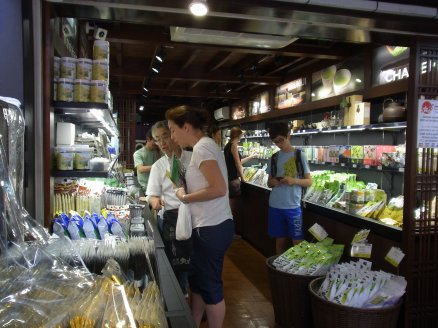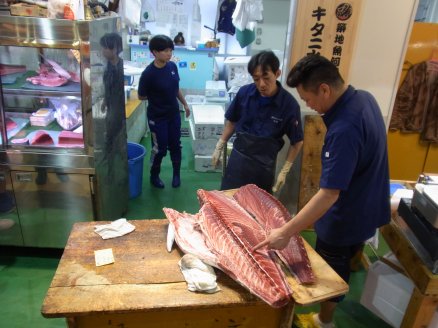
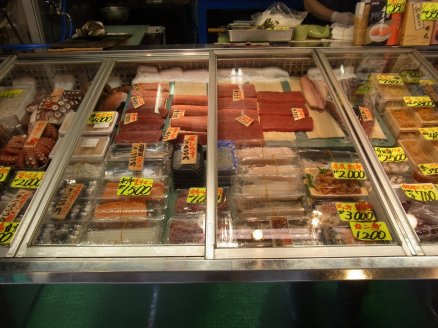
「クロマグロ(黒鮪)」の成魚は、全長3 m・体重400 kgを超え、日本沿岸で漁獲されるマグロ類としては最大種です。
“Kuro-maguro
黒鮪Bluefin tuna” adult fish exceeds 3 m in length and 400 kg in weight,
and is the largest species of tuna caught on the coast of Japan.
The name “Hon-maguro 本鮪 Tuna” is also used when circulated as fresh seafood.
The
migration speed of large individuals is estimated to reach 70-90km / h.
Prey on
other fish, crustaceans including prawns and cephalopods including squids that
swim in the sea during the day.
In the
sea, tuna opens its mouth and “Era-buta 鰓蓋Gill cover”, swims,
and breathes in the water passing through it.
Therefore,
it will continue to swim even when sleeping, as it will suffocate if it stop
swimming.
In 2002,
the Kinki University Fisheries Research Institute succeeded in the complete
aquaculture of “Kuro-maguro” for the first time in the world.
マグロの身は、背中側と腹側では脂肪の含有量が異なります。
Tuna has
different fat content on the back and ventral sides.
そして、「赤身」、「中トロ」、「大トロ」などに分けられます。
It can
be divided into “Akami 赤身 Lean red tuna flesh”,
“Chū-toro 中トロ Medium fatty-tuna flesh”, “Ō-toro 大トロ Fatty-tuna flesh” and so on.
Rare
parts of “Medama 目玉 Eyeball”, “Noten 脳天 Head meat”, “Kama カマ(鰓蓋) Gill cover”,
“Onomi 尾の身Tail”, “Naizou 内臓 Internal organs” are also delicious and popular.
In
addition to “Kuro-maguro”, “Minami-maguro 南鮪 Southern bluefin tuna”,
“Mebachi 目鉢 Bigeye tuna”, “Binnaga 鬢長 Albacore tuna”, “Kihada 黄肌 Yellow tuna”,
“Koshinaga 腰長 Longtail tuna”, “Taiseiyou-maguro 大西洋黒鮪Blackfin tuna” are included in the Tuna family.
Bones of
“Maguro 鮪 Tuna” are excavated from the “Kai-zuka 貝塚 shell mound” during the “Jomon-jidai 縄文時代 Period (before 3000 year ago)”.
From this, it is known that Japanese have
been eating “Maguro 鮪 Tuna” since “Kodai 古代 Ancient times”.
There
are a wide variety of ways to eat, such as “Sashimi 刺身”, “Sushi-neta 寿司ネタ Ingredients for Sushi”,
“Nabe (Negima) 鍋(葱鮪)Hot pot (boiled with green onion)”, “Yaki-zakana 焼き魚 Grilled fish” “Nitsuke 煮付けBoiled hard with
soy sauce” “Tsukudani 佃煮Boiled down in sweetened soy”.
“Nama-maguro
生鮪 Raw tuna” for immediate consumption as “Sashimi” and “Sushi”, and “Reito-maguro
冷凍鮪 Frozen tuna” for preservation are sold.
The fat portion of “Toro トロ” is a particularly perishable part.
In the
old days, it was unpopular enough to be slurred as a “Neko-matagi 猫またぎ Cat stride over the toro”.
「江戸時代」中期から「醤油」が普及するようになりました。
“Shōyu
And “Zuke
冷凍技術の進歩で、「トロ」が長期間保存できるようになりました。
With the
advancement of the refrigeration technology, “Toro Tuna” can be stored for a
long time.
In
addition, “Toro Tuna” has come to be valued with a tendency to prefer a rich
taste since the 1960s.
“Kajiki 梶木Swordfish” is a fish that migrates as fast as “Maguro”.
There is
an upper jaw called “Hun 吻 Sharp mouth” that stretches like a sword, and is said to penetrate the
wood used to steer the ship.
It is
said that the maximum migratory speed reaches 100 km / h.
“Ma-kajiki


刺身や寿司など生の魚を使った料理がある日本料理では、魚の鮮度が重視されます。
Japanese
cuisine with raw fish dishes such as “Sashimi 刺身” and “Sushi すし” emphasizes the
freshness of the fish.
From the
time when they are landed and died, the fish will become less fresh.
Cold
storage in ice or in a refrigerator can slow the decline in freshness.
In the
early Edo period, a method called “Ikejime 活け締め” was developed in Japan.
“Ikejime
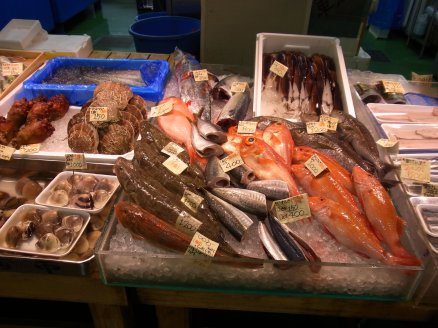
「江戸時代」に中国(清)との貿易で、中華料理の重要な食材として日本から「乾物」が中国へ輸出されました。
In “Edo-jidai
江戸時代
Period”, Japanese “Kanbutsu 乾物 Dried food” have been exported to China (清/Qing) as important ingredients of Chinese cuisine.
“Iri-namako
煎海鼠 Roasted sea cucumber”, “Hoshi-awabi 乾鮑/干鮑 Dried scallops”, and “Fuka-hire 鱶鰭 Sgarj's fin” were particularly very famous.
“Kanbutsu
乾物” include “Kanten 寒天 Agar”, “Konbu 昆布 Kelp”, “Katsuobushi 鰹節 Dried bonito” and “Surume
鯣 Dried squid”.
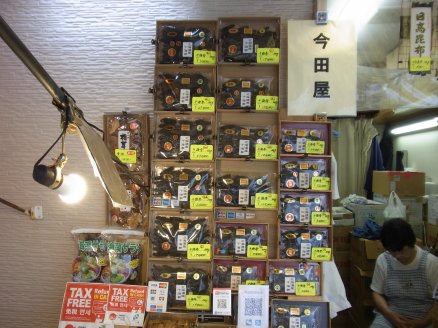
In
addition to vegetables, “Sansai 山菜 Edible wild plants”, beans, “Kinoko きのこ Mushrooms” and fruits, tea, “Kōya- dōfu 高野豆腐” and dried noodles are also included in “Kanbutsu”.
“Himono 干物 Dried seafood” is “Kanbutsu” that has been dried by “Tenpi 天日 Sunlight” or wind to preserve seafood for a long time.
By
evaporating the water, the activity of the microbes is suppressed, and a film
is formed on the surface to improve the storage stability.
In
addition, it has had the unique textures at biting “Himono”, and the protein is
decomposed to produce “Umami 旨味 flavor”.
As
making “Himono”, there are traditional salting and air-drying process and “Himono”
is divided into whole and semi-dried products.
It is
said that “Himono” was offered to the court in the “Nara-jidai 奈良時代 Period (710-794)”.
During
the “Edo-jidai 江戸時代 Period”, it spread widely to the
general public.
Drying methods are roughly divided into “Tenpi-Kansō 天日乾燥 Sun drying” and “Jinkou-Kansō 人工乾燥 Artificial drying”.
“Tenpi-Kansō” is also called “Tenpi-boshi 天日干し Sunlight drying”.
In
Summer fishes may be dried by “Hikage-Boshi 日陰干し Shade drying” to avoid the rot.
“Himono”
are classified into “Su-boshi
“Sulume スルメ Dried sqsuid” and “Migaki-nishin Dried herring” are “Su-boshi”.
“Mezashi
目刺 Sardin” and “Karasumi カラスミ Salt pickled
mullet roe”, “Aramaki-jake 新巻鮭 Solting Salmon” are “Shio-boshi”.
“Chirimen-jako
縮緬雑魚 Sardin” are “Ni-boshi”.
“Kanten
It is
said “Mirin-boshi 味醂干し Seasoned drying” that small fishes
such as “Iwashi 鰯 Sardin” and “Aji 鰺 Horse mackerel” are opened and seasoned with “Mirin 味醂 Sweet sake for seasoning” and “Shouyu 醤油 Soy sauce” dried.
It is “Maru-boshi
丸干し Whole drying” that fishes are just dried without removing internal
organs.
Small
fishes like “Iwashi” are made as “Maru-boshi”.
It is “Hiraki-boshi
開き干し Open and drying” that fishes are opened and taken out the internal
organs and dried.
“Hiraki-boshi”
are used for “Sanma 秋刀魚 Saury”, “Aji”, “Saba 鯖 Mackerel”, “Hokke 𩸽 Okhotsk
atka mackerel”, “Kamasu 魳 Barracuda”, “Kichiji
吉知次 Thornhead” etc.
The cut
and dried fishes are “Kiri-boshi
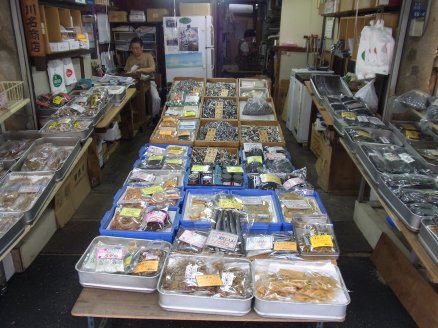
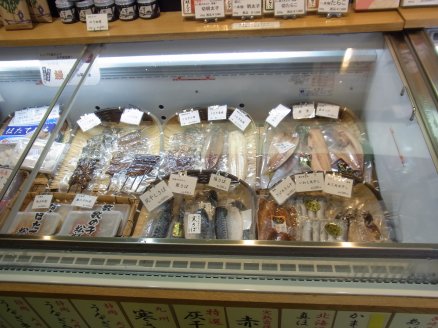
「鰹節」は、日本料理に最も無くてはならない要素である「だし/出し汁」を作るために使用されてきました。
“Katsuo-bushi 鰹節 Dried Bonito Flakes” used to make “Dashi 出汁 Clear fish stock” which is the most essential ingredient in
Japanese cuisine.
Bonito
go through a rigorous process of boiling, “Kunsei 燻製 Smoking”, fermenting, and drying.
Bonito
stopped after the process of smoking are called “Araboshi 粗干し Dried” and the ones stopped after the fermenting stop are called
“Karebushi 涸れ干し Dried”.
“Kezuribushi
削り節 Bonito flakes” are rich in Vitamin-Bs and inosinic acid, which is a
natural source of the “Umami 旨味 Flavor”.
「浅草海苔」は「海苔」のブランドの一つとして有名です。
“Asakusa-nori
浅草海苔 Seaweed” is famous as one of the “Nori 海苔 Seaweed” brand.
When you
stand some bamboos or trees with branches called “Hibi
Originally,
“Hibi” were used as a fishing trap.
Cultivation of “Nori Seaweed” by this method began in the lower “Sumida-gawa
Asakusa
was a production site for “Sukigae-shi 漉返紙 Paper” in “Edo-jidai
江戸時代
Period”.
In “Edo-jidai Period”, there are various types of paper from high-grade
to low-cost, and low-priced paper is used for “Otoshi-gami 落とし紙 Toilet paper”.
The technology
of “Kami-suki 紙漉き Paper-making” was used to make the
paper-like dried “Ita Nori 板海苔” in Asakusa.
Asakusa
has gradually moved away from the coastline during “Edo-jidai Period”.
“Asakusa-nori
(type) アサクサノリ” harvested in “Shinagawa 品川” and “Kasai 葛西(Shimousa-no-kuni 下総国)” has been sold under the brand of “Asakusa-nori”.
“Tokyo-wan
東京湾 Bay” was No. 1 “Nori” production area of Japan until the early “Showa
昭和 Era”.
“Asakusa-nori
(type)” is a first-class type with both taste and fragrance, but it is
difficult to cultivate.
Since 1960s, “Asakusa-nori (type)” has decreased sharply due to the cultivation
of “Susabi-nori スサビノリ
Seaweed” etc.
But currently,
activities to revive “Asakusa-nori” is also carried out.
「米」や「麦」以外の、「粟(アワ)」、「稗(ヒエ)」、「蕎麦(ソバ)」、「黍(キビ)」などの「穀類」が「雑穀」です。
Other than “Kome
“Kibi”
is a popular “Millet” in Japan, and “Kibi dango 黍団子 Sweat” is famous.
One of
the favorite and easiest ways to incorporate millets in your diet is to mix
them with rice, and let the rice cooker do the job.
You will also find various kinds of beans including “Azuki
Both “Zakkoku” and beans are high in fiber and nutrition and are recognized
for our health benefits.
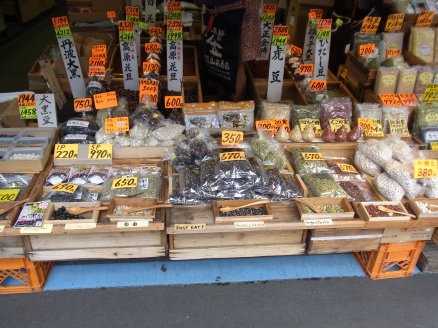
魚を各種の調味料や専用の「漬け床」などに漬ける目的は、保存や風味づけなどです。
The
purpose of soaking the fish in various seasonings and a special “Tsuke-doko 漬け床” is for preservation and flavoring.
Sometimes
it can be soaked for a long time using fermentation.
It is common to soak using the crystals of salt, but when make fish into
“Himono 干物 Dried fish”, make deep salt water and immerse.
Soaking “Shōyu 醤油 Soy sauce” is “Shōyu –zuke 醤油漬け”.
Soaking
in “Miso
“Saikyō-zuke”
is made by adding “Sawara 鰆 Sierra”, “Gindara 銀鱈 Sablefish”, “Managatsuo 真名鰹 Silver pomfret”,
“Sake 鮭 Sarmon”, etc. to “Tsuke-doko” with “Mirin 味醂” and “Sake 酒” added to “Saikyō-Miso
西京味噌”, baked and eaten.
Soaking
in “Nuka-doko 糠床” made by mixing salt and so on with
“Kamenuka 米糠” is “Nuka-zuke ぬか漬け”.
Soaking
in “Tsuke-doko” mixtured salt and rice with “Kome-kōji 米麹” is “Kōji-zuke 麹漬け”.
Soaking
in “Sake-kasu 酒粕”, a by-product of sake, is “Kasu-zuke 粕漬け”.
Pickling
in “Ki-zu 生酢 Pure vinegar” or “Awase-zu 合わせ酢 Vinegar” blended with spices and seasonings is “Su-zuke 酢漬け”.
“Saba 鯖 Mackerel”, “Kohada/Konoshiro 鮗 Threadfin shad” and
“Nishin 鰊 Herring” are soused in “Ki-zu”.
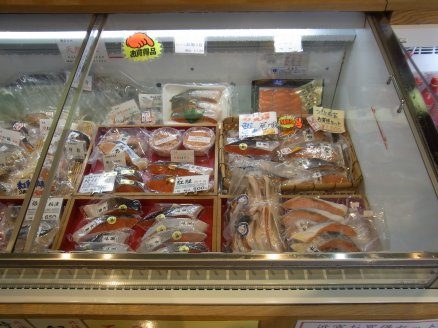
「佃煮」は、小魚や貝、海藻などの食材を、「醤油」と「味醂」、「砂糖」で甘辛く煮付けた日本の食べ物です。
“Tsukudani
佃煮” is made by simmering the ingredients, small fish, shellfish and
seaweed in “Shōyu 醤油 Soy sauce”, “Mirin 味醂 Sweet sake for seasoning”, and “Sato 砂糖 sugar”.
During
the “Edo-jidai 江戸時代 Period”, fishermen of “Tsukuda-jima 佃島 Island” used to eat “Tsukudani” as a home-made regular dish and
preserved food to eat during bad weather and as an on-board meal during
fishing.
When a
lot of “Zako 雑魚 Small fish” were caught, they made “Tsukudani”
and sold its.
“Tsukudani”
has become popular with the common people in Edo, because those can be
preserved, has a rich flavor, and is inexpensive.
It is
said that “Tsukudani” has spread throughout the country because “Bushi 武士 Samurai” has taken home them as “Miyage 土産 Souvenir” from Edo at “Sankin-kōtai 参勤交代”.
「イナゴ」をはじめとする昆虫類や牛肉の佃煮もあります。
There
are also “Tsukudani” that are made from insects, including “Inago 蝗 Locust” and beef.
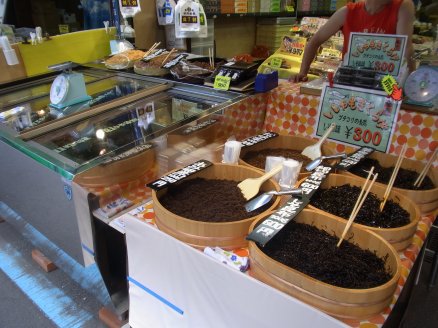
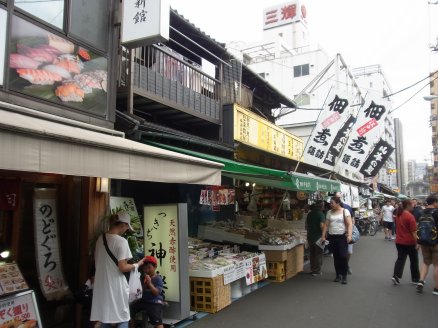
「玉子焼き」は一般的に、四角い専用の鍋で厚みのある方形に巻き上げて整形する厚焼き卵です。
“Tamago-yaki 玉子焼き Japanese omelet” is a thick baked egg that is generally rolled up
(cooking together layers of egg) and shaped into a thick square in a
rectangular pan.
From the
middle of “Edo-jidai 江戸時代 Period”, square-shaped pans were
used.
Sweet “Tamago-yaki” made with only sugar and “Dashi/Dashijiru 出し汁 Soup stock” is
called “Dashimaki-tamago だし巻き卵 Egg”.
Sweet “Tamago-yaki” is one of Japan’s unique home-cooked dishes, and is
one of staple dishes for “Bento 弁当 Box lunch”.
“Tamago-yaki”, a traditional “Neta ネタ Ingredient” of “Sushi” from “Edo-jidai
Period”, is also called “Gyoku ギョク”.
It is baked
like sponge over a low flame by adding “Surimi すり身 Ground fish” of “Shiromi-zakana 白身魚 White fish” and “Shiba-ebi 芝海老 Shrimp”, and “Tororo-imo とろろ芋 Grated yam” and sugar into eggs.
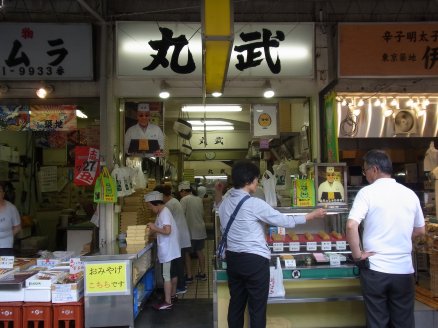
日本のピクルスは「漬物」と呼ばれ、ご飯にぴったりのお供です。
Japanese
pickles are called “Tsukemono
Some
examples of pickled vegetables are “Daikon 大根 Radishes”, “Kabu 蕪 Turnips”, “Kyūri 胡瓜 Cucumbers”, “Nasu 茄子 Eggplants”, and “Gobō
牛蒡 Burdock roots”.
There
are several different seasonings for pickling processes including salt, “Miso 味噌 Soybean paste”, “Shōyu 醤油 Soy sauce”, “Su 酢 Vinegar”, “Kome-nuka 米糠 Rice bran”, and “Sake
kasu 酒粕 Sake lees”.
You may
be pleasantly surprised by the variety and the vivid colors of these delectable
side dishes.
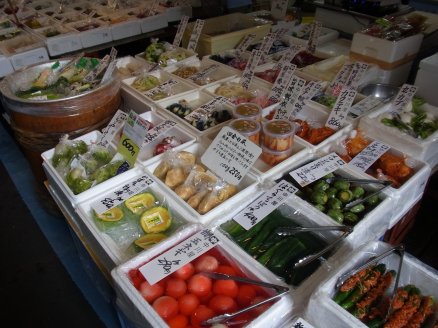
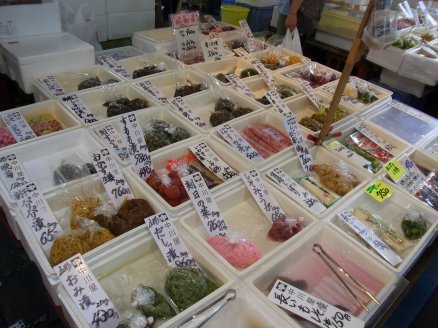
「ねりもの」とは、魚の「すり身」と調味料を使用した調理済みの料理を意味します。
“Nerimono
Some
examples of “Nerimono” are “Satsuma-age 薩摩揚げ”, “Chikuwa 竹輪”, “Hampen はんぺん” and “Tsumire つみれ”.
“Oden 御田” is a very popular “Nabe-ryōri 鍋料理 Cooking” that is a dish cooked in a pot at the table, and “Neta ネタ Ingredients” are simmered in a light “Dashi 出し汁 Soup stock” with “Kobu 昆布 Dry kelp” and “Katsuo-bushi 鰹節 Dried bonito” added some seasoning including “Shōyu 醤油 Soy sauce”.
Popular “Neta”
of “Oden” are “Yude-tamago 茹で卵 Boiled egg”, “Daikon
大根 Radish”, “Kon-nyaku 蒟蒻 Konjak”, and “Nerimono
練り物 Processed fishcake” and so on, and there are difference between regions or families.
“Oden”
was originally called “Miso-dengaku 味噌田楽” or simply “Dengaku 田楽” that was “Kon-nyaku Konjak” with “Miso 味噌 Soybean paste”.
In “Edo-jidai
江戸時代
Period”, instead of using “Miso”, “Oden”, which boils “Neta”,
became popular as “Yatai-ryōri 屋台料理 Street foods” that were served at carts or stands.
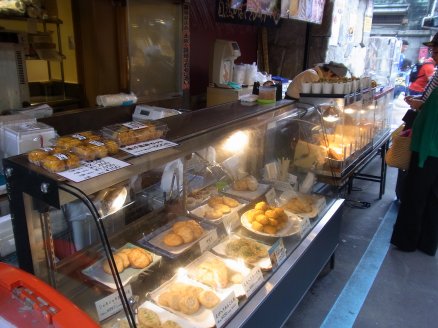
市場の卸売店では、日本の高級なレストランで「珍味」として提供される食材も扱っています。
Wholesale
stores in the Market also cater to high-end, gourmet Japanese restaurants,
Delicacies, known in Japan as “Chinmi 珍味 Delicacies”, are
readily available here.
“Chinmi”
is a food that is rare because the food itself is rare, and the appearance and taste
are completely contrary.
They can
be rather expensive but well worth the price for the epicure/gourmet.
The
taste of food that everyone can feel delicious is called “Kou
The
three major “Chinmi” in the world are caviar, truffles and foie gras.
The
three best known “Chinmi” in Japan are “Shio-uni 海胆 Salt pickled Sea urchin roe”, “Karasumi カラスミ Salt pickled mullet roe” and “Konowata このわた Pickled sea cucumber innards”.
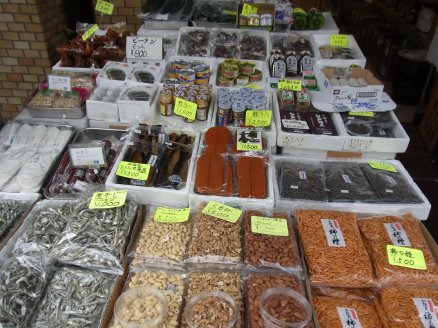
「緑茶」は、「烏龍茶」や「紅茶」と異なり、摘み取った「茶葉」を加熱処理して発酵を妨げたお茶です。
Unlike “Wūron-cha 烏龍茶 Oolong tea” and “Kou-cha 紅茶 Black tea”, “Ryoku-cha 緑茶 Green tea” is a tea made from “Cha-ba 茶葉 Tea leaves” that harvested and has been heat-treated to prevent fermentation.
「茶葉」を蒸した後、手の平で揉みながら形を整えて、乾燥させます。
After steaming
the “Cha-ba 茶葉”, prepare with palms of the hand while
shaping and dry.
「緑茶」は「日本茶」とも言われ、「和食(日本食)」に欠かせないものとして、日本で最も多く飲まれています。It is also known as “Nihon-cha
「寿司」や「和菓子」と一緒に飲んだり、「和食」を食べた後に飲んだりするが一般的でした。It was common to drink with “Sushi
「日常茶飯(事)」という言葉は、ありふれたことを意味します。
The word
“Nichijou-sahan (ji) 日常茶飯(事) Everyday incident” means something
common.
「抹茶」は日本で800年以上にわたって飲まれてきました。
“Matcha 抹茶” has been drunk in Japan for over 800 years.
他の「日本茶」と同じ様に、「抹茶」も乾燥させた「茶葉」から作ります。
Like
other kinds of “Nihon-cha 日本茶 Japanese tea”,
“Matcha” is made from the dried “Cha-ba 茶葉”.
“Cha-ba 茶葉” are covered with shade for
more than 2 weeks (20 days) to avoid direct sunlight before harvest in the “Cha-batake
茶畑 Tea plantations”.
This
process began in “Azuchi-momoyama-jidai 安土桃山時代 Period”.
The
high-grade tea “Gyokuro 玉露” is also protected
from sunlight for increasing “Umami 旨味 Taste” and
reducing “Shibumi 渋み Astringency taste.
In
addition to “Umami”, basic tastes include “Amami 甘味 Sweet”, “Sanmi 酸味 Sour, “Siomi 塩味 Salty” and “Nigami 苦味 Bitter”.
“Karami 辛味 Hot taste" and “Shibumi 渋み Astringent” are
similar to sense of touch, and there is
no sensory organs on the tongue.
After
steaming “Cha-ba 茶葉” harvested, it is“Tencha 碾茶”that has been dried without shaping with palm of hands.
It is
"Matcha 抹茶" that ground this “Tencha 碾茶” into fine powder with "Cha-usu 茶臼 Tea mill (millstone)".
Until
the Edo period, people used to pour and drink tea using freshly made
"Matcha".
“Matcha”
is placed directly in the “Matcha-Jawan 抹茶茶碗 Tea cup” from
which it will be drunk.
Hot
water is added, using a “Hishaku 柄杓 Bamboo scoop”.
Then it is whisked briskly, using a “Chasen 茶筅 Tea whisk”, also
made from bamboo.
Once the “Matcha” is properly mixed with the water, it's ready to be drunk.
These days, “Matcha” is no longer confined the “Cha-kai 茶会 Tea ceremony”.
“Matcha” is regarded as a healthy drink and used as an ingredient in many
types of food.
The
unique fragrance and flavor of “Matcha” go well with dairy products, too.
It is
also widely used as an ingredient for “Wa-gashi 和菓子 Japanese-style confectionery” and “You-gashi 洋菓子 Western confectionery”.
Today its popularity is gradually spreading around the world.
